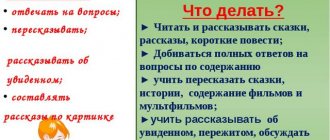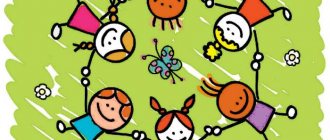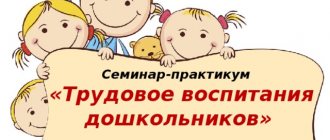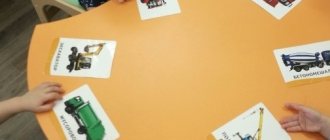The teacher’s speech is the main thing in raising a child in kindergarten
Gulnara Nagaeva
The teacher’s speech is the main thing in raising a child in kindergarten
The main role in the development of speech and replenishment of the child’s vocabulary is played by the teacher and his speech , since the preschooler spends most of the time during this period of his life with him. Enrichment and activation of vocabulary must begin from a very early age of the child . And in the future we need to further improve it and increase it. Only a child with a rich vocabulary can develop correct, literate speech . The teacher’s task is to optimize the process of speech development and vocabulary enrichment as much as possible. Children spend most of their time in kindergarten with teachers . The teacher's speech is an example for children. It is this that they focus on when pronouncing the words they know. Children try to copy the teacher’s intonations depending on the properties of the event being described, just as the teacher in his stories about the same events. the teacher's speech sounds , the more correct the speech of his students . The teacher must improve and develop his speech and pronunciation, since his mistakes will entail hundreds of mistakes of his pupils , which are easier to correct at an early age than at an older age.
By using various methods of teaching speech development and vocabulary enrichment, you can achieve more tangible results than if you use template techniques. Children are interested in a change in activity and therefore the process of mastering knowledge will proceed more interestingly, lively and without tiring preschoolers. Having developed speech , a child will be better prepared for school. The knowledge will be easier , and there will be fewer problems when communicating with peers and answering at the board.
Knowing that preschool children master language on the basis of oral speech, through communication with people around them, the following should be taken into account. 1. The teacher’s speech is a model for children in the broad sense of the word, primarily in colloquial speech, on the basis of which the child’s daily communication with the teacher . 2. During classes, children, listening to the teacher’s speech , practice mastering the Russian language. the teacher's colloquial speech are passed on to the children, and then the children have difficulty getting rid of them already at school.
The teacher's speech should be:
1) grammatically correctly constructed, coherent;
2) with a clear and distinct pronunciation of all sounds of the native language;
3) maintained at a certain tempo and volume;
4) intonationally expressive;
5) understandable;
6) with the correct and accurate use of verbal notations.
Requirements for teacher speech Correctness - compliance of speech with language norms. When communicating with children, the teacher uses the basic norms of the Russian language: orthoepic norms (rules of literary pronunciation, as well as norms for the formation and change of words. Accuracy is the correspondence of the semantic content of speech and the information that underlies it. The teacher must pay special attention to the semantic (semantic) )
side of speech, because this contributes to the development of children’s skills in accurate word use.
Logicity is the expression in semantic connections of the components of speech and the relationships between the parts and components of thought. the teacher takes into account that in preschool age ideas about the structural components of a coherent utterance are formed and the skills of using various methods within text communication are formed. Purity is the absence in speech of elements alien to the literary language. Taking into account the leading mechanism of speech development of preschoolers (imitation), the teacher takes care of the purity of his own speech: the use of filler words, dialect and slang words is unacceptable.
Expressiveness is a feature of speech that captures attention and creates an atmosphere of emotional empathy. The expressiveness of the teacher’s is a powerful tool for influencing child A teacher who is proficient in various means of expressive speech (intonation, tempo of speech, strength, pitch of voice, etc., contributes not only to the formation of the arbitrary expressiveness of a child's , but also to a more complete awareness of the content of an adult's speech, and the formation of the ability to express his attitude to the subject of conversation.
Richness is the ability to use all linguistic units in order to optimally express information. The teacher’s rich vocabulary the child’s vocabulary , helps to develop his skills in accurate word usage, expressiveness and figurative speech, since in preschool age the foundations of the child’s .
Relevance is the use in speech of units that correspond to the situation and conditions of communication. The appropriateness of the teacher’s speech presupposes , first of all, having a sense of style. Taking into account the specifics of preschool age aims the teacher at developing a culture of speech behavior in children (communication skills, the ability to use various formulas of speech etiquette, focus on the communication situation, the interlocutor, etc.).
Some shortcomings of the teacher’s speech:
1) haste in speech (accelerated pace makes it unclear, blurry, difficult to understand )
2) slurred pronunciation;
3) monotony of speech (it tires listeners and reduces interest in the content)
;
4) increased voice volume (turning into screaming)
.If necessary
(noise in a group, for example),
you should increase the volume slightly and pronounce the words more clearly, noticing the tempo;
5) inaccuracy in the pronunciation of individual sounds or words;
6) violations of vocabulary - grammatical design;
7) the use of parasite words in speech;
 careless, sloppy pronunciation (the endings of words are not pronounced, individual sounds are swallowed, consonants are pronounced indistinctly);
careless, sloppy pronunciation (the endings of words are not pronounced, individual sounds are swallowed, consonants are pronounced indistinctly);
9) letter-by-letter pronunciation of some words: what (instead of what, his (instead of evo, happiness (happiness)
etc. ; that is, as we write so we speak;
10) speech with a national accent, with characteristic features of local dialects: yakan, clack, etc.;
11) pronouncing words with incorrect stress;
12) dissonance of voice (hoarseness, hoarseness, nasality)
.
The shortcomings of educators’ vocabulary (speech) include :
1) frequent use of words with diminutive - affectionate suffixes (Tanechka, cup, pens, etc.)
;
2) speech is clogged with unnecessary words (well, that’s what it means, so to speak)
;
3) when communicating with older children, adapting to the children’s speech ;
4) use, use of new words in speech, not taking into account the age of the children.
Thus, when working with children, the teacher should pay attention to the following:
1) correctly pronounce all sounds of the native language, eliminate existing speech defects;
2) have clear, precise and distinct speech , i.e. good diction;
3) use literary pronunciation in your speech, i.e. adhere to spelling norms;
4) strive to correctly use intonational means of expression, taking into account the content of the statement;
5) when communicating with children, use speech at a slightly slower pace and moderate voice volume;
6) tell and convey the content of texts in a coherent and accessible form, accurately using words and grammatical structures (according to the age of the children)
;
7) the teacher’s speech must be calm, always balanced, polite not only towards children, but also towards all employees of the kindergarten (rude expressions are not allowed)
.
What should a modern teacher be like?
A good modern teacher is a kind of quintessence:
- good education;
- manners;
- love for children;
- pedagogical excellence;
- creative potential.
His work is constant work on himself, his thoughts and actions. Today, the requirements for a teacher, made both by parents of students and directors, and by the public as a whole, are as follows:
- A good education.
- A set of personal and professional qualities.
- Competent speech of the teacher.
- A decent appearance and image of a teacher in the eyes of the public.
- Special knowledge, skills and abilities necessary for a teacher.
This list is not complete and has many more additions. Let's try to consider each of the points in more detail.
What kind of education do you need to have?
A preschool teacher, by definition, is a person who has received the appropriate secondary specialized and/or higher education.
Today, most employers require a potential applicant to have a higher education in the field of “Preschool Pedagogy”. However, as experience shows, sometimes college education is enough for a good teacher. This is due to the number of hours of practice, which are more within the vocational education system than at universities.
During his specialized education, a preschool teacher masters disciplines in the following areas:
- Age-related psychology.
- Physiology, anatomy and hygiene.
- Methods of teaching mathematics, drawing, physical education, reading, counting and applied arts.
Thanks to this, in the course of his work, one teacher is able to teach your child the basics of counting and reading, drawing and music .
A set of personal and professional qualities that must be possessed
You cannot teach a child without showing him a personal example. A child in preschool age relies not so much on the words of an adult, but on his behavior. Therefore, serious demands are placed on the teacher’s personality.
It is unlikely that a person who does not have such qualities as humanity, responsiveness, honesty, respect for juniors and elders, diligence, goodwill, etc. will be able to teach a child any of the above.
No less demands are placed on professional qualities. The teacher should always focus on the interests of the children, not have “favorites ,” and treat everyone equally with love and respect. Accept that each of his pupils is a small child, but at the same time an individual.
The professional qualities of a teacher also include his desire to educate his students, hard work, and the ability to set goals and achieve them during the educational process.
Grammatically correct speech
In the tender age of childhood, when the child’s vocabulary is just being formed, but is growing very quickly, it is necessary that the language environment around is clean, correct, without slang, bureaucracy and cliches.
The teacher’s speech should be simple and understandable to the child, but at the same time clear and concise.
Correct accents and pronunciation are very important, because a child enriches his vocabulary by relying on the adults around him, and the role of the teacher in shaping the child’s speech cannot be underestimated!
Appearance and social image
Unlike schools, preschool institutions do not set strict limits on the appearance of teachers, however, there should be clear limits here too.
How does a kindergarten teacher dress? It is unacceptable for a teacher to come to work in open T-shirts, blouses and shirts with a deep neckline or made of translucent materials.
It is also necessary to emphasize that in our time, when social networks have become ubiquitous, a teacher should not post compromising photographs of himself on his pages on VKontakte, Instagram or Facebook.
The image of a teacher, including on social networks, should inspire trust and respect among parents.
What should you know and be able to do?
As we said earlier, during the course of his training, the future teacher becomes acquainted with the peculiarities of the psychology of children of primary school age.
Also, all teachers undergo courses in physiology, hygiene, and medicine.
This is necessary not only to teach the child simple rules for caring for his body, but also so that in case of emergency, the teacher can provide assistance to the students.
The teacher needs to know what to do if his pupils have a fever or rashes , what to do if the baby does not feel well or there are significant changes in his behavior.
Sometimes a teacher needs to be a subtle observer in order to see and feel what is happening with the children entrusted to him.
Humanity, tolerance and tact
The fundamental triad of a good teacher is humanity, tolerance and pedagogical tact . It is the educator who must instill in the child humanity towards the peers and adults around him.
Under the strict guidance of the teacher, the child must learn to solve problems in communicating with children, learn not only to be friends, but also to forgive offenders.
An equally important quality is tolerance. The teacher must be impartial and accept his students regardless of who their parents are.
It is also important that the teacher treats the child as a whole person. A good teacher understands that his students are equal people and will not allow himself to raise his voice or insult the child.
The final quality of our triad is pedagogical tact. A qualified teacher always takes into account the individual characteristics of each child and tries to help overcome difficulties, and never emphasizes the weaknesses of his students.
Read about the responsibilities and rights of a kindergarten teacher and nanny on our website.







